Literature Review: PET Scans for Pediatric Neuroblastoma Diagnosis
VerifiedAdded on 2022/12/26
|8
|1916
|61
Literature Review
AI Summary
This literature review examines the use of Positron Emission Tomography (PET) scans in the diagnosis, staging, and treatment monitoring of pediatric neuroblastoma. It contrasts PET imaging with traditional methods like radiography, CT scans, and MRI, highlighting PET's advantages in detecting skeletal metastases and assessing treatment response. The review emphasizes PET's ability to visualize physiological and biochemical changes early in the disease process, its non-invasive nature, and its superior resolution for detecting small lesions and soft tissue involvement. It also discusses the use of F-DOPA PET and FDG PET in neuroblastoma imaging, noting the increasing adoption of FDG PET for its concentration at tumor sites. Ultimately, the review concludes that PET scanning is a valuable tool for improving the initial staging and management of neuroblastoma in children, offering more detailed and functional information compared to conventional imaging techniques. Desklib provides access to similar documents and study resources for students.
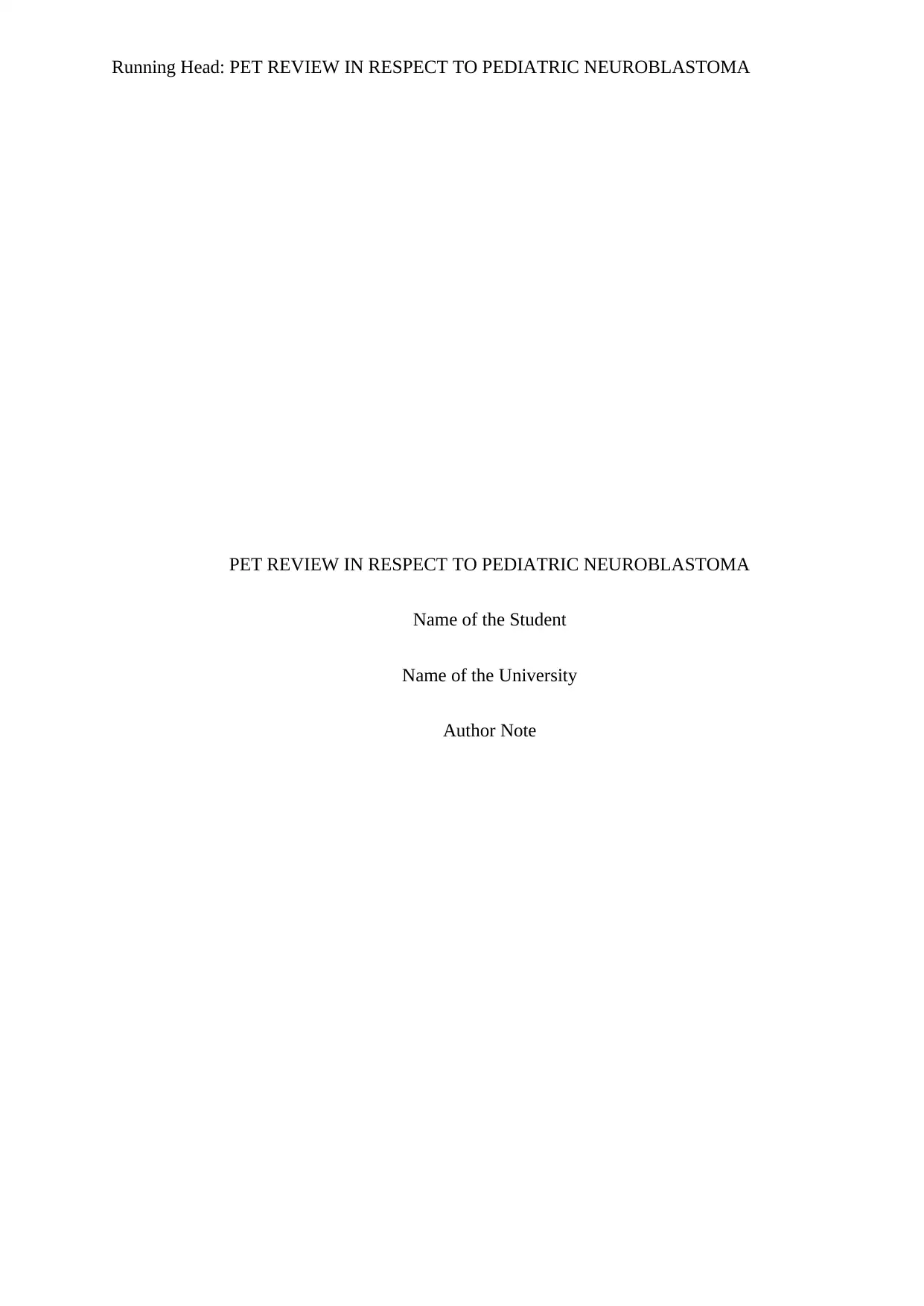
Running Head: PET REVIEW IN RESPECT TO PEDIATRIC NEUROBLASTOMA
PET REVIEW IN RESPECT TO PEDIATRIC NEUROBLASTOMA
Name of the Student
Name of the University
Author Note
PET REVIEW IN RESPECT TO PEDIATRIC NEUROBLASTOMA
Name of the Student
Name of the University
Author Note
Paraphrase This Document
Need a fresh take? Get an instant paraphrase of this document with our AI Paraphraser
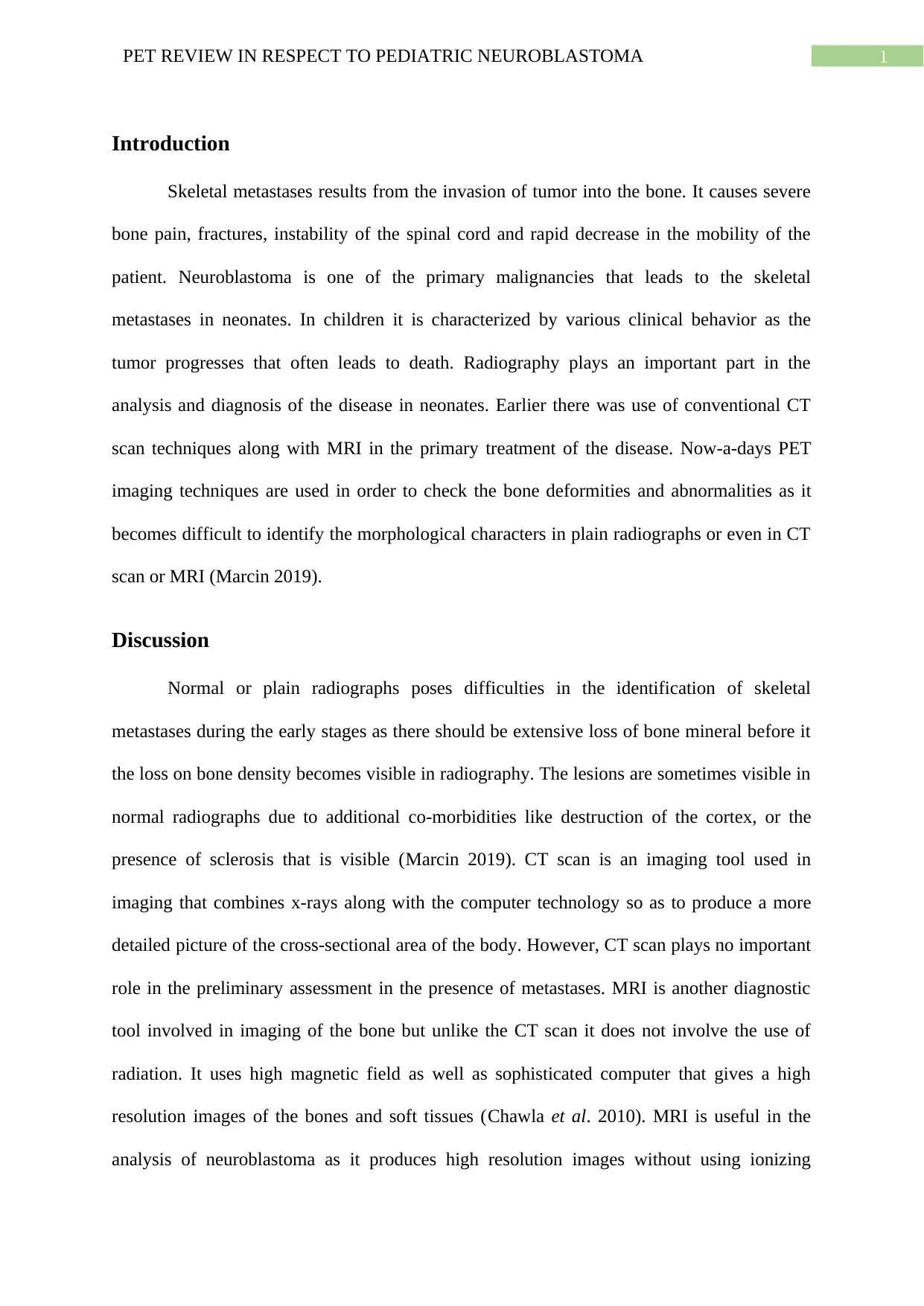
1PET REVIEW IN RESPECT TO PEDIATRIC NEUROBLASTOMA
Introduction
Skeletal metastases results from the invasion of tumor into the bone. It causes severe
bone pain, fractures, instability of the spinal cord and rapid decrease in the mobility of the
patient. Neuroblastoma is one of the primary malignancies that leads to the skeletal
metastases in neonates. In children it is characterized by various clinical behavior as the
tumor progresses that often leads to death. Radiography plays an important part in the
analysis and diagnosis of the disease in neonates. Earlier there was use of conventional CT
scan techniques along with MRI in the primary treatment of the disease. Now-a-days PET
imaging techniques are used in order to check the bone deformities and abnormalities as it
becomes difficult to identify the morphological characters in plain radiographs or even in CT
scan or MRI (Marcin 2019).
Discussion
Normal or plain radiographs poses difficulties in the identification of skeletal
metastases during the early stages as there should be extensive loss of bone mineral before it
the loss on bone density becomes visible in radiography. The lesions are sometimes visible in
normal radiographs due to additional co-morbidities like destruction of the cortex, or the
presence of sclerosis that is visible (Marcin 2019). CT scan is an imaging tool used in
imaging that combines x-rays along with the computer technology so as to produce a more
detailed picture of the cross-sectional area of the body. However, CT scan plays no important
role in the preliminary assessment in the presence of metastases. MRI is another diagnostic
tool involved in imaging of the bone but unlike the CT scan it does not involve the use of
radiation. It uses high magnetic field as well as sophisticated computer that gives a high
resolution images of the bones and soft tissues (Chawla et al. 2010). MRI is useful in the
analysis of neuroblastoma as it produces high resolution images without using ionizing
Introduction
Skeletal metastases results from the invasion of tumor into the bone. It causes severe
bone pain, fractures, instability of the spinal cord and rapid decrease in the mobility of the
patient. Neuroblastoma is one of the primary malignancies that leads to the skeletal
metastases in neonates. In children it is characterized by various clinical behavior as the
tumor progresses that often leads to death. Radiography plays an important part in the
analysis and diagnosis of the disease in neonates. Earlier there was use of conventional CT
scan techniques along with MRI in the primary treatment of the disease. Now-a-days PET
imaging techniques are used in order to check the bone deformities and abnormalities as it
becomes difficult to identify the morphological characters in plain radiographs or even in CT
scan or MRI (Marcin 2019).
Discussion
Normal or plain radiographs poses difficulties in the identification of skeletal
metastases during the early stages as there should be extensive loss of bone mineral before it
the loss on bone density becomes visible in radiography. The lesions are sometimes visible in
normal radiographs due to additional co-morbidities like destruction of the cortex, or the
presence of sclerosis that is visible (Marcin 2019). CT scan is an imaging tool used in
imaging that combines x-rays along with the computer technology so as to produce a more
detailed picture of the cross-sectional area of the body. However, CT scan plays no important
role in the preliminary assessment in the presence of metastases. MRI is another diagnostic
tool involved in imaging of the bone but unlike the CT scan it does not involve the use of
radiation. It uses high magnetic field as well as sophisticated computer that gives a high
resolution images of the bones and soft tissues (Chawla et al. 2010). MRI is useful in the
analysis of neuroblastoma as it produces high resolution images without using ionizing
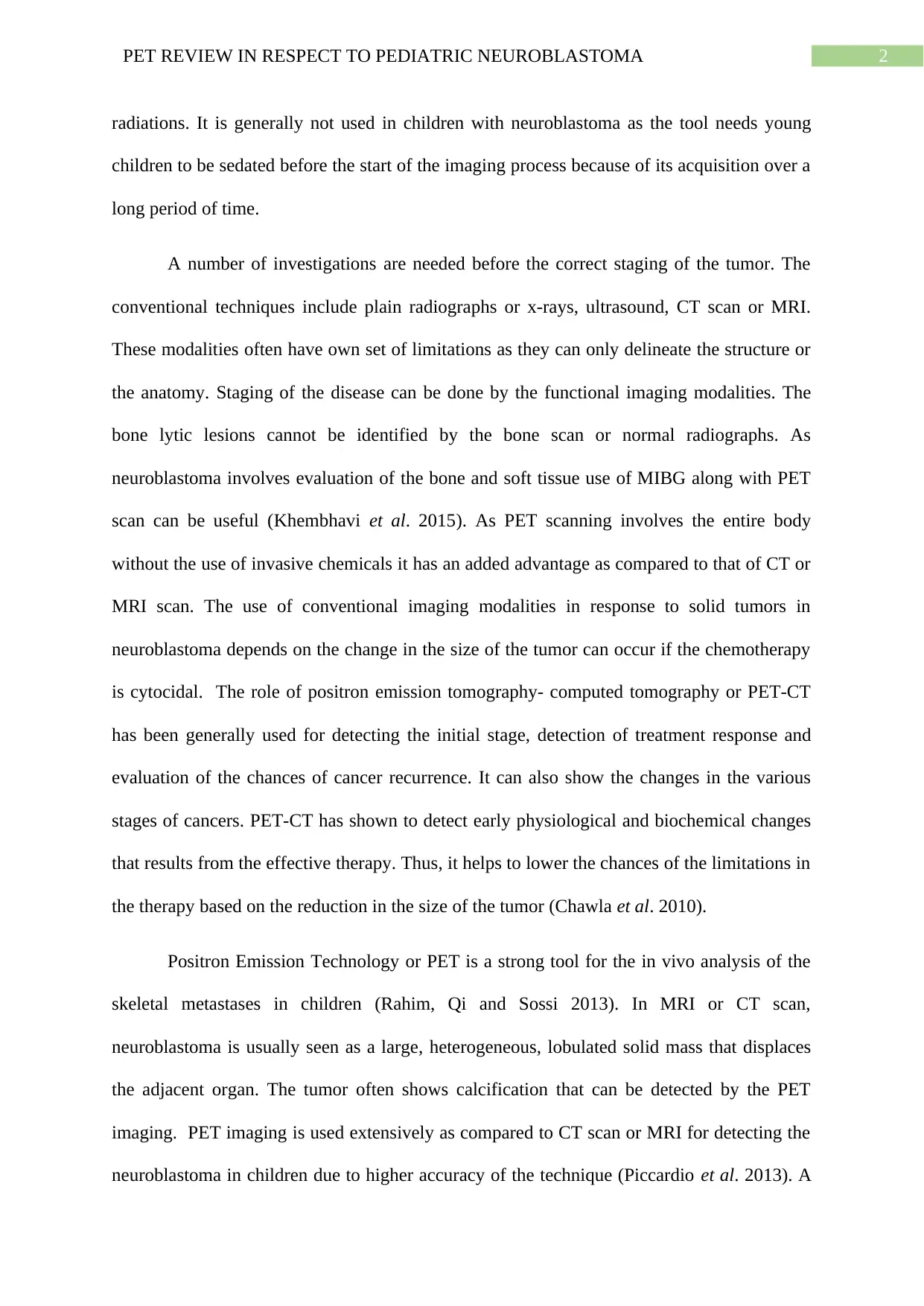
2PET REVIEW IN RESPECT TO PEDIATRIC NEUROBLASTOMA
radiations. It is generally not used in children with neuroblastoma as the tool needs young
children to be sedated before the start of the imaging process because of its acquisition over a
long period of time.
A number of investigations are needed before the correct staging of the tumor. The
conventional techniques include plain radiographs or x-rays, ultrasound, CT scan or MRI.
These modalities often have own set of limitations as they can only delineate the structure or
the anatomy. Staging of the disease can be done by the functional imaging modalities. The
bone lytic lesions cannot be identified by the bone scan or normal radiographs. As
neuroblastoma involves evaluation of the bone and soft tissue use of MIBG along with PET
scan can be useful (Khembhavi et al. 2015). As PET scanning involves the entire body
without the use of invasive chemicals it has an added advantage as compared to that of CT or
MRI scan. The use of conventional imaging modalities in response to solid tumors in
neuroblastoma depends on the change in the size of the tumor can occur if the chemotherapy
is cytocidal. The role of positron emission tomography- computed tomography or PET-CT
has been generally used for detecting the initial stage, detection of treatment response and
evaluation of the chances of cancer recurrence. It can also show the changes in the various
stages of cancers. PET-CT has shown to detect early physiological and biochemical changes
that results from the effective therapy. Thus, it helps to lower the chances of the limitations in
the therapy based on the reduction in the size of the tumor (Chawla et al. 2010).
Positron Emission Technology or PET is a strong tool for the in vivo analysis of the
skeletal metastases in children (Rahim, Qi and Sossi 2013). In MRI or CT scan,
neuroblastoma is usually seen as a large, heterogeneous, lobulated solid mass that displaces
the adjacent organ. The tumor often shows calcification that can be detected by the PET
imaging. PET imaging is used extensively as compared to CT scan or MRI for detecting the
neuroblastoma in children due to higher accuracy of the technique (Piccardio et al. 2013). A
radiations. It is generally not used in children with neuroblastoma as the tool needs young
children to be sedated before the start of the imaging process because of its acquisition over a
long period of time.
A number of investigations are needed before the correct staging of the tumor. The
conventional techniques include plain radiographs or x-rays, ultrasound, CT scan or MRI.
These modalities often have own set of limitations as they can only delineate the structure or
the anatomy. Staging of the disease can be done by the functional imaging modalities. The
bone lytic lesions cannot be identified by the bone scan or normal radiographs. As
neuroblastoma involves evaluation of the bone and soft tissue use of MIBG along with PET
scan can be useful (Khembhavi et al. 2015). As PET scanning involves the entire body
without the use of invasive chemicals it has an added advantage as compared to that of CT or
MRI scan. The use of conventional imaging modalities in response to solid tumors in
neuroblastoma depends on the change in the size of the tumor can occur if the chemotherapy
is cytocidal. The role of positron emission tomography- computed tomography or PET-CT
has been generally used for detecting the initial stage, detection of treatment response and
evaluation of the chances of cancer recurrence. It can also show the changes in the various
stages of cancers. PET-CT has shown to detect early physiological and biochemical changes
that results from the effective therapy. Thus, it helps to lower the chances of the limitations in
the therapy based on the reduction in the size of the tumor (Chawla et al. 2010).
Positron Emission Technology or PET is a strong tool for the in vivo analysis of the
skeletal metastases in children (Rahim, Qi and Sossi 2013). In MRI or CT scan,
neuroblastoma is usually seen as a large, heterogeneous, lobulated solid mass that displaces
the adjacent organ. The tumor often shows calcification that can be detected by the PET
imaging. PET imaging is used extensively as compared to CT scan or MRI for detecting the
neuroblastoma in children due to higher accuracy of the technique (Piccardio et al. 2013). A
⊘ This is a preview!⊘
Do you want full access?
Subscribe today to unlock all pages.

Trusted by 1+ million students worldwide
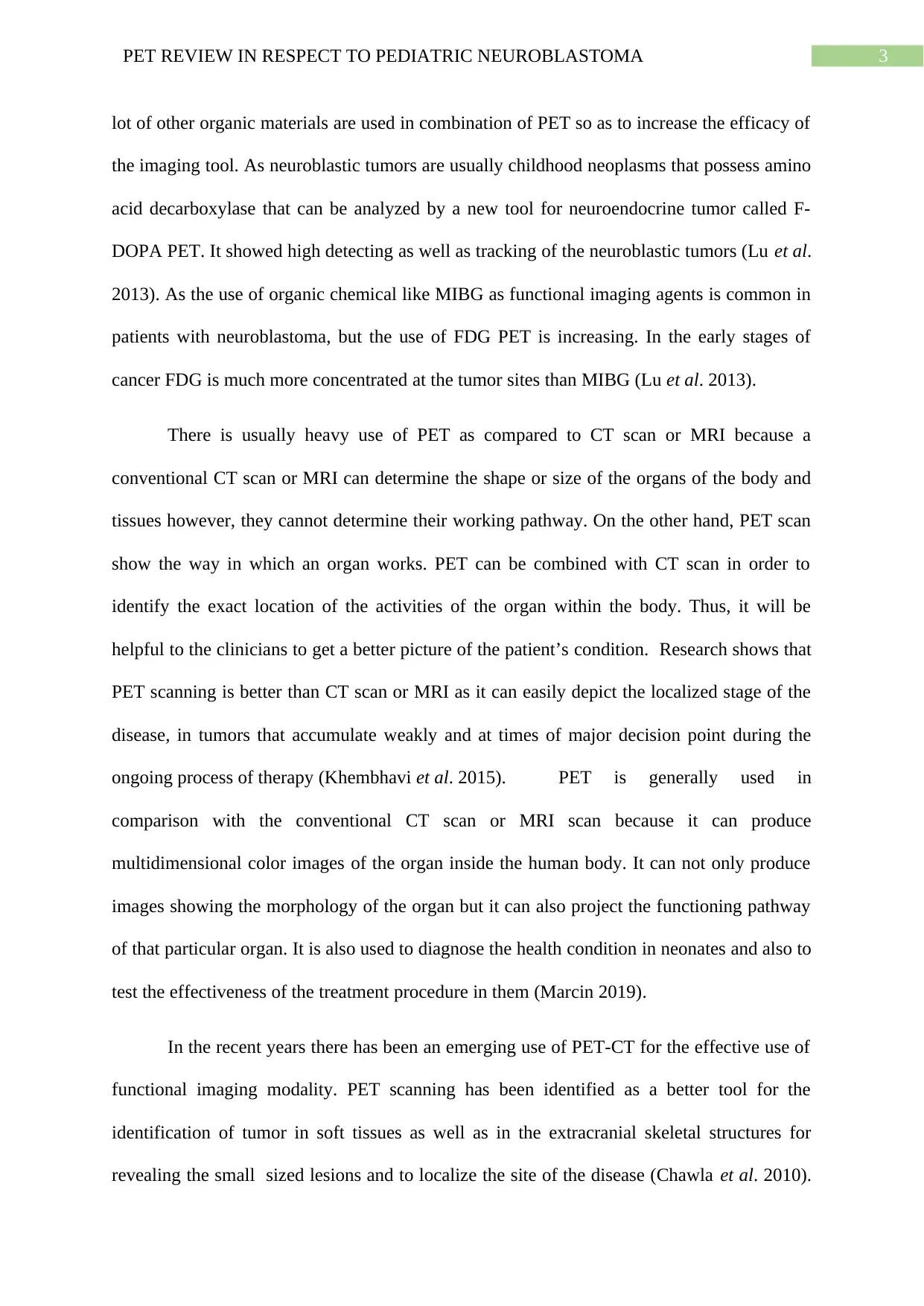
3PET REVIEW IN RESPECT TO PEDIATRIC NEUROBLASTOMA
lot of other organic materials are used in combination of PET so as to increase the efficacy of
the imaging tool. As neuroblastic tumors are usually childhood neoplasms that possess amino
acid decarboxylase that can be analyzed by a new tool for neuroendocrine tumor called F-
DOPA PET. It showed high detecting as well as tracking of the neuroblastic tumors (Lu et al.
2013). As the use of organic chemical like MIBG as functional imaging agents is common in
patients with neuroblastoma, but the use of FDG PET is increasing. In the early stages of
cancer FDG is much more concentrated at the tumor sites than MIBG (Lu et al. 2013).
There is usually heavy use of PET as compared to CT scan or MRI because a
conventional CT scan or MRI can determine the shape or size of the organs of the body and
tissues however, they cannot determine their working pathway. On the other hand, PET scan
show the way in which an organ works. PET can be combined with CT scan in order to
identify the exact location of the activities of the organ within the body. Thus, it will be
helpful to the clinicians to get a better picture of the patient’s condition. Research shows that
PET scanning is better than CT scan or MRI as it can easily depict the localized stage of the
disease, in tumors that accumulate weakly and at times of major decision point during the
ongoing process of therapy (Khembhavi et al. 2015). PET is generally used in
comparison with the conventional CT scan or MRI scan because it can produce
multidimensional color images of the organ inside the human body. It can not only produce
images showing the morphology of the organ but it can also project the functioning pathway
of that particular organ. It is also used to diagnose the health condition in neonates and also to
test the effectiveness of the treatment procedure in them (Marcin 2019).
In the recent years there has been an emerging use of PET-CT for the effective use of
functional imaging modality. PET scanning has been identified as a better tool for the
identification of tumor in soft tissues as well as in the extracranial skeletal structures for
revealing the small sized lesions and to localize the site of the disease (Chawla et al. 2010).
lot of other organic materials are used in combination of PET so as to increase the efficacy of
the imaging tool. As neuroblastic tumors are usually childhood neoplasms that possess amino
acid decarboxylase that can be analyzed by a new tool for neuroendocrine tumor called F-
DOPA PET. It showed high detecting as well as tracking of the neuroblastic tumors (Lu et al.
2013). As the use of organic chemical like MIBG as functional imaging agents is common in
patients with neuroblastoma, but the use of FDG PET is increasing. In the early stages of
cancer FDG is much more concentrated at the tumor sites than MIBG (Lu et al. 2013).
There is usually heavy use of PET as compared to CT scan or MRI because a
conventional CT scan or MRI can determine the shape or size of the organs of the body and
tissues however, they cannot determine their working pathway. On the other hand, PET scan
show the way in which an organ works. PET can be combined with CT scan in order to
identify the exact location of the activities of the organ within the body. Thus, it will be
helpful to the clinicians to get a better picture of the patient’s condition. Research shows that
PET scanning is better than CT scan or MRI as it can easily depict the localized stage of the
disease, in tumors that accumulate weakly and at times of major decision point during the
ongoing process of therapy (Khembhavi et al. 2015). PET is generally used in
comparison with the conventional CT scan or MRI scan because it can produce
multidimensional color images of the organ inside the human body. It can not only produce
images showing the morphology of the organ but it can also project the functioning pathway
of that particular organ. It is also used to diagnose the health condition in neonates and also to
test the effectiveness of the treatment procedure in them (Marcin 2019).
In the recent years there has been an emerging use of PET-CT for the effective use of
functional imaging modality. PET scanning has been identified as a better tool for the
identification of tumor in soft tissues as well as in the extracranial skeletal structures for
revealing the small sized lesions and to localize the site of the disease (Chawla et al. 2010).
Paraphrase This Document
Need a fresh take? Get an instant paraphrase of this document with our AI Paraphraser
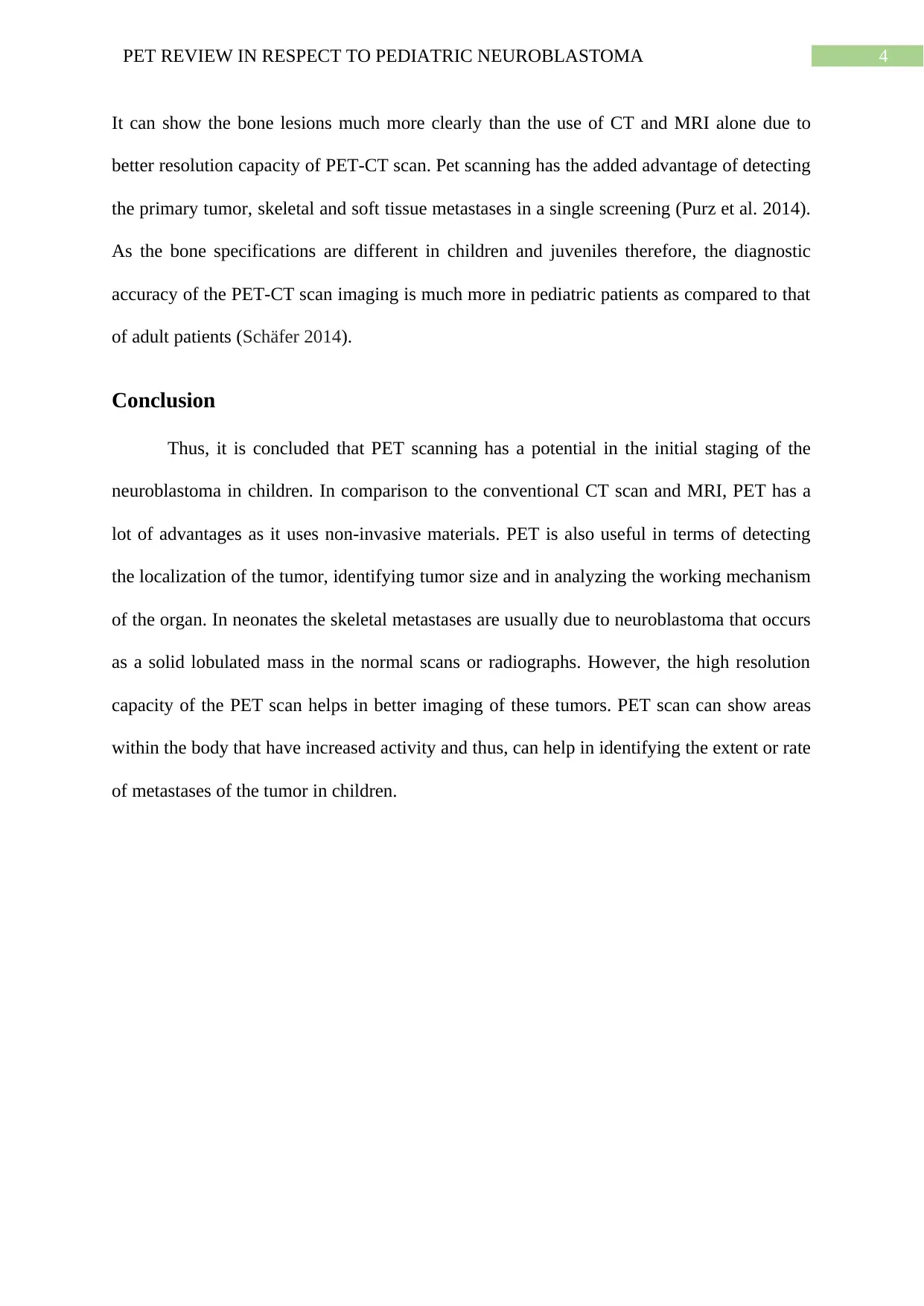
4PET REVIEW IN RESPECT TO PEDIATRIC NEUROBLASTOMA
It can show the bone lesions much more clearly than the use of CT and MRI alone due to
better resolution capacity of PET-CT scan. Pet scanning has the added advantage of detecting
the primary tumor, skeletal and soft tissue metastases in a single screening (Purz et al. 2014).
As the bone specifications are different in children and juveniles therefore, the diagnostic
accuracy of the PET-CT scan imaging is much more in pediatric patients as compared to that
of adult patients (Schäfer 2014).
Conclusion
Thus, it is concluded that PET scanning has a potential in the initial staging of the
neuroblastoma in children. In comparison to the conventional CT scan and MRI, PET has a
lot of advantages as it uses non-invasive materials. PET is also useful in terms of detecting
the localization of the tumor, identifying tumor size and in analyzing the working mechanism
of the organ. In neonates the skeletal metastases are usually due to neuroblastoma that occurs
as a solid lobulated mass in the normal scans or radiographs. However, the high resolution
capacity of the PET scan helps in better imaging of these tumors. PET scan can show areas
within the body that have increased activity and thus, can help in identifying the extent or rate
of metastases of the tumor in children.
It can show the bone lesions much more clearly than the use of CT and MRI alone due to
better resolution capacity of PET-CT scan. Pet scanning has the added advantage of detecting
the primary tumor, skeletal and soft tissue metastases in a single screening (Purz et al. 2014).
As the bone specifications are different in children and juveniles therefore, the diagnostic
accuracy of the PET-CT scan imaging is much more in pediatric patients as compared to that
of adult patients (Schäfer 2014).
Conclusion
Thus, it is concluded that PET scanning has a potential in the initial staging of the
neuroblastoma in children. In comparison to the conventional CT scan and MRI, PET has a
lot of advantages as it uses non-invasive materials. PET is also useful in terms of detecting
the localization of the tumor, identifying tumor size and in analyzing the working mechanism
of the organ. In neonates the skeletal metastases are usually due to neuroblastoma that occurs
as a solid lobulated mass in the normal scans or radiographs. However, the high resolution
capacity of the PET scan helps in better imaging of these tumors. PET scan can show areas
within the body that have increased activity and thus, can help in identifying the extent or rate
of metastases of the tumor in children.

5PET REVIEW IN RESPECT TO PEDIATRIC NEUROBLASTOMA
⊘ This is a preview!⊘
Do you want full access?
Subscribe today to unlock all pages.

Trusted by 1+ million students worldwide
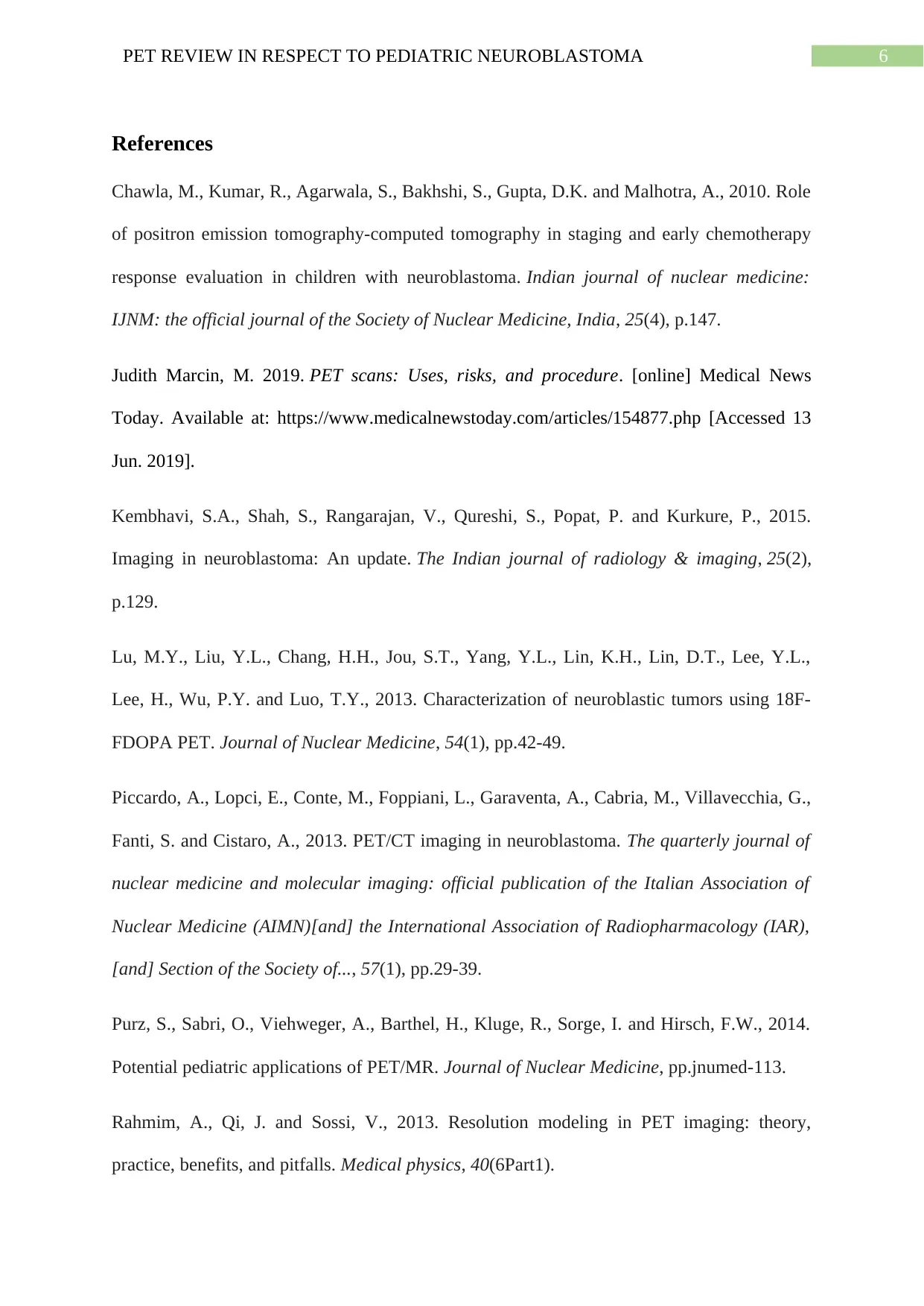
6PET REVIEW IN RESPECT TO PEDIATRIC NEUROBLASTOMA
References
Chawla, M., Kumar, R., Agarwala, S., Bakhshi, S., Gupta, D.K. and Malhotra, A., 2010. Role
of positron emission tomography-computed tomography in staging and early chemotherapy
response evaluation in children with neuroblastoma. Indian journal of nuclear medicine:
IJNM: the official journal of the Society of Nuclear Medicine, India, 25(4), p.147.
Judith Marcin, M. 2019. PET scans: Uses, risks, and procedure. [online] Medical News
Today. Available at: https://www.medicalnewstoday.com/articles/154877.php [Accessed 13
Jun. 2019].
Kembhavi, S.A., Shah, S., Rangarajan, V., Qureshi, S., Popat, P. and Kurkure, P., 2015.
Imaging in neuroblastoma: An update. The Indian journal of radiology & imaging, 25(2),
p.129.
Lu, M.Y., Liu, Y.L., Chang, H.H., Jou, S.T., Yang, Y.L., Lin, K.H., Lin, D.T., Lee, Y.L.,
Lee, H., Wu, P.Y. and Luo, T.Y., 2013. Characterization of neuroblastic tumors using 18F-
FDOPA PET. Journal of Nuclear Medicine, 54(1), pp.42-49.
Piccardo, A., Lopci, E., Conte, M., Foppiani, L., Garaventa, A., Cabria, M., Villavecchia, G.,
Fanti, S. and Cistaro, A., 2013. PET/CT imaging in neuroblastoma. The quarterly journal of
nuclear medicine and molecular imaging: official publication of the Italian Association of
Nuclear Medicine (AIMN)[and] the International Association of Radiopharmacology (IAR),
[and] Section of the Society of..., 57(1), pp.29-39.
Purz, S., Sabri, O., Viehweger, A., Barthel, H., Kluge, R., Sorge, I. and Hirsch, F.W., 2014.
Potential pediatric applications of PET/MR. Journal of Nuclear Medicine, pp.jnumed-113.
Rahmim, A., Qi, J. and Sossi, V., 2013. Resolution modeling in PET imaging: theory,
practice, benefits, and pitfalls. Medical physics, 40(6Part1).
References
Chawla, M., Kumar, R., Agarwala, S., Bakhshi, S., Gupta, D.K. and Malhotra, A., 2010. Role
of positron emission tomography-computed tomography in staging and early chemotherapy
response evaluation in children with neuroblastoma. Indian journal of nuclear medicine:
IJNM: the official journal of the Society of Nuclear Medicine, India, 25(4), p.147.
Judith Marcin, M. 2019. PET scans: Uses, risks, and procedure. [online] Medical News
Today. Available at: https://www.medicalnewstoday.com/articles/154877.php [Accessed 13
Jun. 2019].
Kembhavi, S.A., Shah, S., Rangarajan, V., Qureshi, S., Popat, P. and Kurkure, P., 2015.
Imaging in neuroblastoma: An update. The Indian journal of radiology & imaging, 25(2),
p.129.
Lu, M.Y., Liu, Y.L., Chang, H.H., Jou, S.T., Yang, Y.L., Lin, K.H., Lin, D.T., Lee, Y.L.,
Lee, H., Wu, P.Y. and Luo, T.Y., 2013. Characterization of neuroblastic tumors using 18F-
FDOPA PET. Journal of Nuclear Medicine, 54(1), pp.42-49.
Piccardo, A., Lopci, E., Conte, M., Foppiani, L., Garaventa, A., Cabria, M., Villavecchia, G.,
Fanti, S. and Cistaro, A., 2013. PET/CT imaging in neuroblastoma. The quarterly journal of
nuclear medicine and molecular imaging: official publication of the Italian Association of
Nuclear Medicine (AIMN)[and] the International Association of Radiopharmacology (IAR),
[and] Section of the Society of..., 57(1), pp.29-39.
Purz, S., Sabri, O., Viehweger, A., Barthel, H., Kluge, R., Sorge, I. and Hirsch, F.W., 2014.
Potential pediatric applications of PET/MR. Journal of Nuclear Medicine, pp.jnumed-113.
Rahmim, A., Qi, J. and Sossi, V., 2013. Resolution modeling in PET imaging: theory,
practice, benefits, and pitfalls. Medical physics, 40(6Part1).
Paraphrase This Document
Need a fresh take? Get an instant paraphrase of this document with our AI Paraphraser

7PET REVIEW IN RESPECT TO PEDIATRIC NEUROBLASTOMA
Schäfer, J.F., Gatidis, S., Schmidt, H., Gückel, B., Bezrukov, I., Pfannenberg, C.A., Reimold,
M., Ebinger, M., Fuchs, J., Claussen, C.D. and Schwenzer, N.F., 2014. Simultaneous whole-
body PET/MR imaging in comparison to PET/CT in pediatric oncology: initial
results. Radiology, 273(1), pp.220-231.
Schäfer, J.F., Gatidis, S., Schmidt, H., Gückel, B., Bezrukov, I., Pfannenberg, C.A., Reimold,
M., Ebinger, M., Fuchs, J., Claussen, C.D. and Schwenzer, N.F., 2014. Simultaneous whole-
body PET/MR imaging in comparison to PET/CT in pediatric oncology: initial
results. Radiology, 273(1), pp.220-231.
1 out of 8
Related Documents
Your All-in-One AI-Powered Toolkit for Academic Success.
+13062052269
info@desklib.com
Available 24*7 on WhatsApp / Email
![[object Object]](/_next/static/media/star-bottom.7253800d.svg)
Unlock your academic potential
Copyright © 2020–2025 A2Z Services. All Rights Reserved. Developed and managed by ZUCOL.




